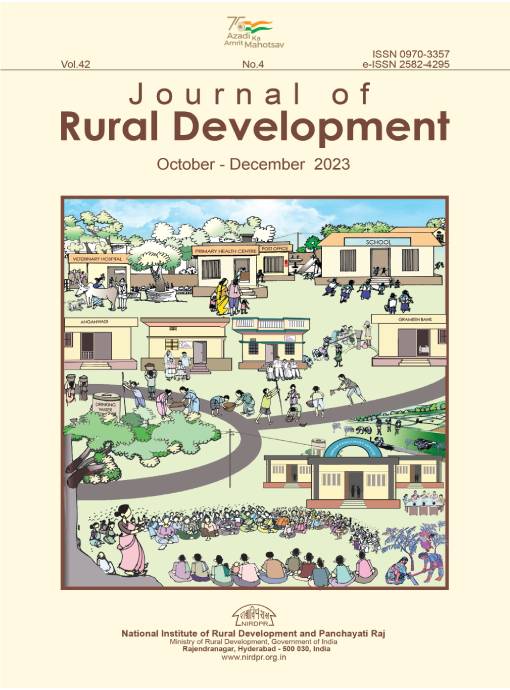Swachh Bharat Mission (Gramin) and Practices of Solid Waste Management in Rural Sikkim
DOI:
https://doi.org/10.25175/jrd/2023/v42/i4/157473Keywords:
Guidelines, Practices, Panchayats, Solid Waste Management, Rural Sikkim.Abstract
Generation of waste and disposal in rural areas has not been the prime focus for deliberation, unlike the urban areas where it is regarded as a crucial issue that demands immediate attention and solution. Until recently, managing solid waste was not considered an issue in rural areas of Sikkim. However, with the proliferation of solid waste in recent years due to increasing population, the growth of tourism industry and changing consumption patterns have prompted the government of Sikkim to decentralise the responsibility of managing solid waste in compliance with the guidelines of Swachh Bharat Mission (Gramin). Based on primary data collected from the two Gram Panchayats, namely Mellidara Paiyong and Lungchok Kamarey in South Sikkim district, the paper attempts to comprehend the various types of waste generated, and critically evaluate the common conventional methods and practices adopted by the villagers for disposal of their household waste. Simultaneously, it also attempts to assess various policies and strategies taken up by the local self-government in managing the solid waste generated from households.
Downloads
Downloads
Published
How to Cite
Issue
Section
References
Beckert, J., & Zafirovski, M. (Ed.). (2006). International Encyclopaedia of Economic Sociology. Routledge.
Boyle, P., & Halfacree, K. (Ed.). (1998). Migration into Rural Areas: Theories and Issues. Wiley.
CEIC (n.d.). Visitor arrivals: Local. Sikkim [Infographic]. https://www.ceicdata.com/en/india/resident-visits-by-states/visitor-arrivals-local-sikkim
Census. (2011). Census of India: Sikkim. https://www.censusindia.co.in/states/sikkim
Department of Economic & Statistical Monitoring & Evaluation (DESME). (2016). Sikkim: A Statistical Journal. Government of Sikkim.
Doron, A., & Jeffrey, R. (2018). Waste of a nation: Garbage and growth in India. Harvard University Press.
Ferronato, N., & Torretta, V. (2019). Waste Mismanagement in Developing Countries: A Review of Global Issues. International Journal of Environmental Research and Public Health, 16(6), 1060. https://doi.org/10.3390/ijerph16061060
FRED. (n.d.). Memorandum to the Fourteenth Finance Commission, vol. - I. (Finance, Revenue & Expenditure Department (FRED), Government of Sikkim.
Giddens, A. (2009). Sociology (6th Ed.). Wiley India Pvt. Ltd.
Jena, M. (2008). Pollution in the Mahanadi: Urban Sewage, Industrial Effluents and Biomedical Waste. Economic and Political Weekly, 43(20),17-23.
Jodhka, S. S. (2012). Caste: Oxford India short introductions. Oxford University Press India.
Johnson, K. (2005). Globalisation at the Crossroads of Tradition and Modernity in Rural India. Sociological Bulletin, 54(1), 40-58. https://doi.org/10.1177/0038022920050103
Mathur, N. (Ed.). (2014). Consumer Culture, Modernity and Identity. Sage Publications India Pvt Ltd.
Mauch, C. (Ed.). (2016). A Future Without Waste? Zero Waste in Theory and Practice. RCC Perspective. Retrieved from http://www.environmentandsociety.org/perspectives/2016/3/future-without-waste-zero
McLuhan, M., & Powers, B. R. (1992). The Global Village: Transformations in World Life and Media in the 21st Century. Oxford University Press.
Mihai, F. C. (2017). Solid Waste Management in Rural Areas. InTech.
Ministry of Drinking Water and Sanitation. (2017). Guidelines for Swachh Bharat Mission (Gramin). https://swachhbharatmission.gov.in/sbmcms/writereaddata/images/pdf/Guidelines/Complete-set-guidelines.pdf
Ramesh, R., & SivaRam, P. (2016). Solid Waste Management in Rural Areas: A Step-by-Step Guide for Gram Panchayats. National Institute of Rural Development & Panchayati Raj, Hyderabad.
Rural Management and Development Department (RMDD). (2018-2019). Annual Report. Government of Sikkim.
Schindler, S., Demaria, F., & Pandit, S. B. (2012). Delhi’s Waste Conflict. Economic and Political Weekly, 47(42), 18-21.
Sharma, P. D. (2015). Ecology and Environment (12th Ed.). Rastogi Publications.
Singh, B. P. (2001). The Eastern Himalaya: Wetlands, Forests and Beliefs. Economic and Political Weekly, 36(31), 4-10.
Telegraph. (2011, June 11). Fine for Plastic Dump on Sikkim Slopes. The Telegraph online. https://www.telegraphindia.com/west-bengal/fine-for-plastic-dump-on-sikkim-slopes/cid/387641
Teltumbde, A. (2014). No Swachh Bharat Without Annihilation of Caste. Economic and Political Weekly, 49 (45), 11-12.
Toxics Link. (2014). Plastics and the Environment: Assessing the Impact of the Complete Ban on Plastic Carry Bag. Toxics Link.
Urban Development & Housing Department. (2019). State Policy on Solid Waste Management Strategy. Sikkim Government Gazette (SGG), Gangtok: Government of Sikkim.
Watanabe, C. (2015). Waste Incorporated. Gastronomica, 15(4), 6-13. https://doi.org/10.1525/gfc.2015.15.4.6
Yoada, R. M., Chirawurah, D., & Adongo, P. B. (2014). Domestic Waste Disposal Practice and Perceptions of Private Sector Waste Management in Urban Accra. BMC Public Health, 14(1), 1-10. https://doi.org/10.1186/1471-2458-14-697






